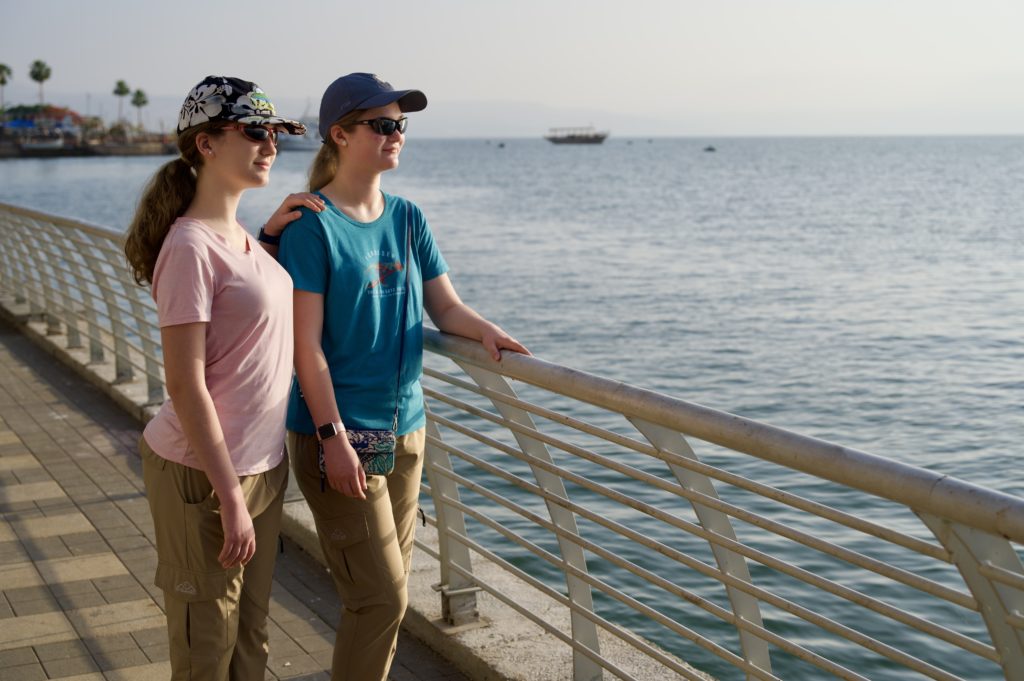
I woke up again at 6am this morning, just before Sara. We had to pack up our luggage since we are transitioning down to the Dead Sea area today. We met Olivia and Kate at 6:40am for a quick walk on the promenade by the Sea of Galilee before breakfast.
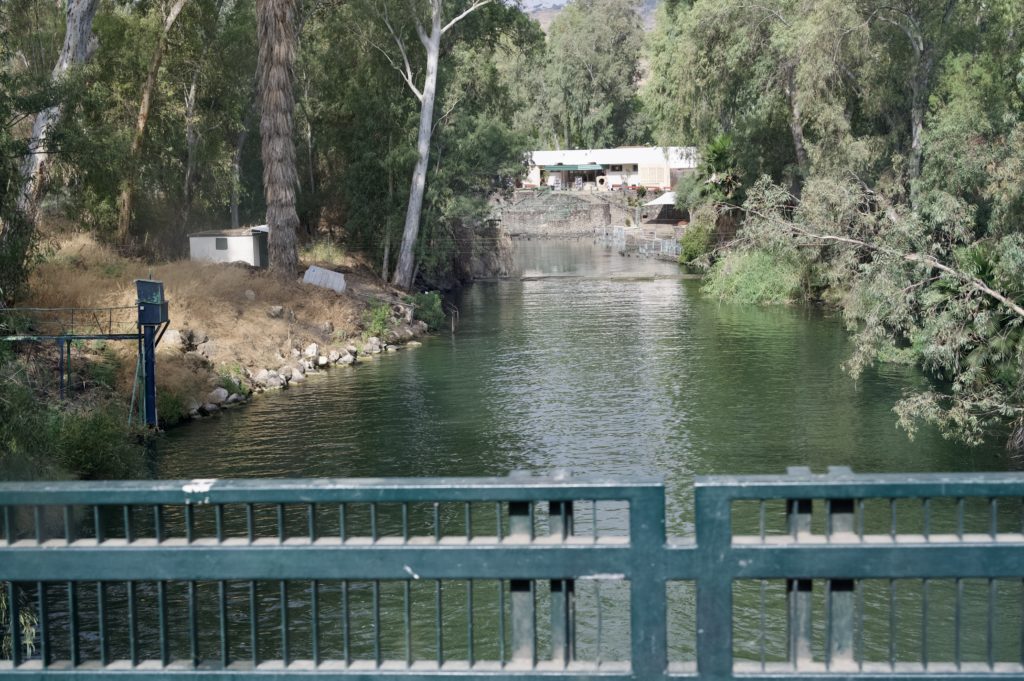
After breakfast, we loaded up the bus and began to head toward our first destination to the south. Along the way we drove down beside the Sea of Galilee and got a glimpse of the Jordan River as it exits the lake.
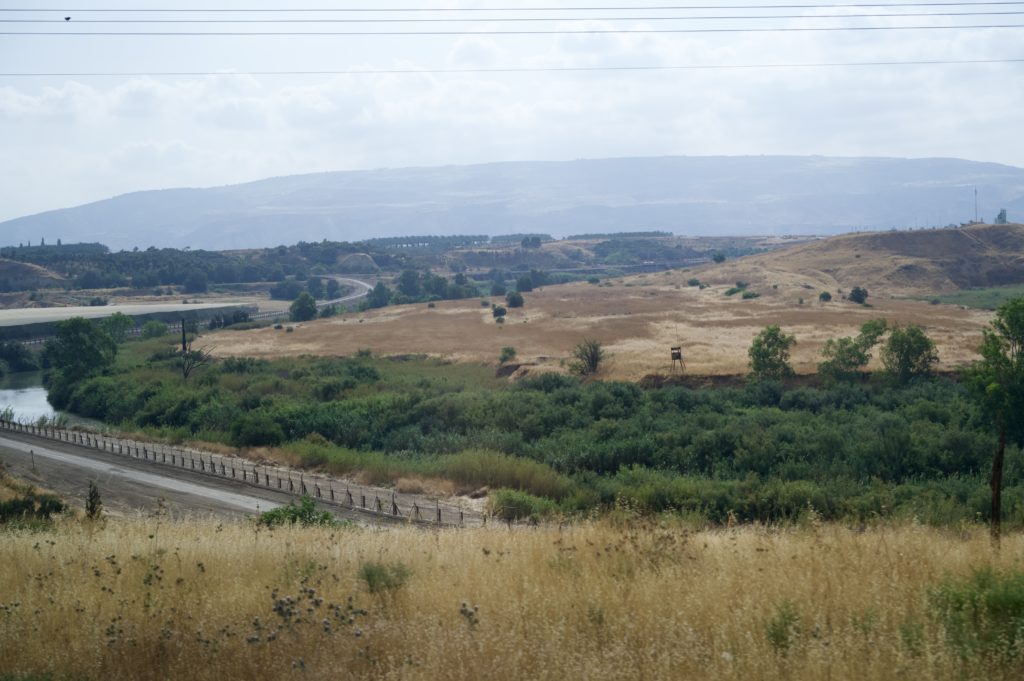
A little further south in the Jordan Valley, Ami pointed out the Jordan River as it curves across the landscape with the country of Jordan just on the other side. He also pointed out the Gilead Mountains in Jordan where the prophet Elijah was from (1 Kings 17:1).
Bet-She’an
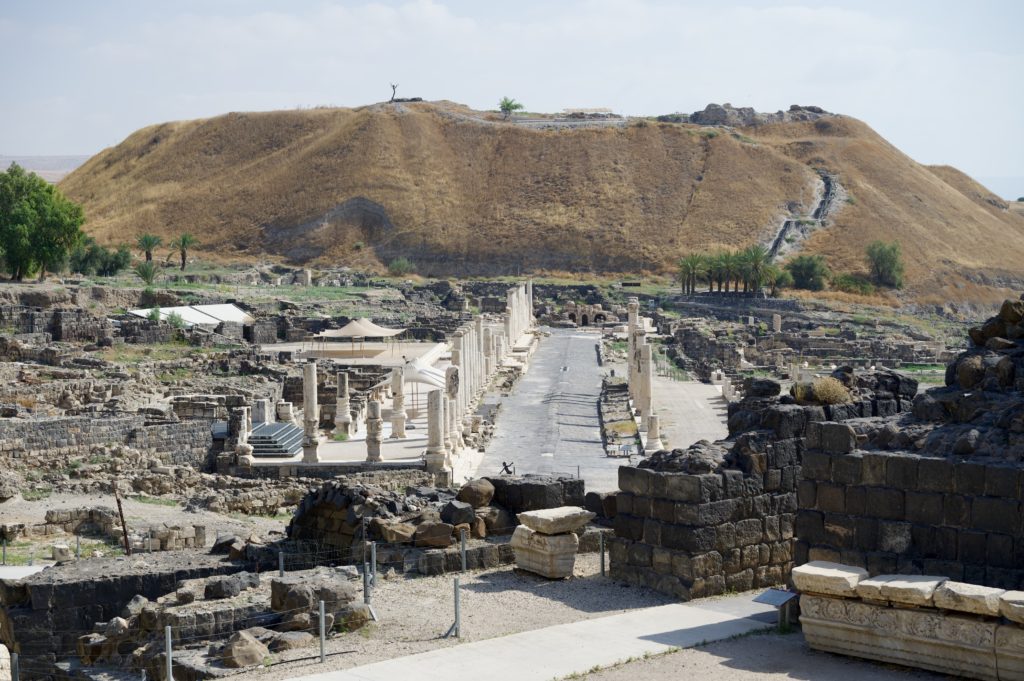
Our first stop today was Bet-She’an, which is an amazing archeological site. Even though Bet-She’an is mentioned in the Bible, most of the excavations today are from the Byzantine Period during the 4th and 5th centuries AD.
The book of Joshua first mentions Bet-She’an as one of the cities of Manasseh. According to Judges 1:27, the city was still inhabited by Canaanites during the period of the judges.
First Samuel records that after the Philistines killed Saul in battle at Mt Gilboa, they hung his body and those of his three sons on the walls of Bet-She’an and placed his armor in the temple of Ashtaroth (1 Sam 31:8–13). According to 1 Chronicles 10:8–12, the Philistines also hung Saul’s head in the temple of Dagon.
Bet-She’an eventually came under Israelite control, and according to 1 Kgs 4:12, it became one of King Solomon’s administrative districts.
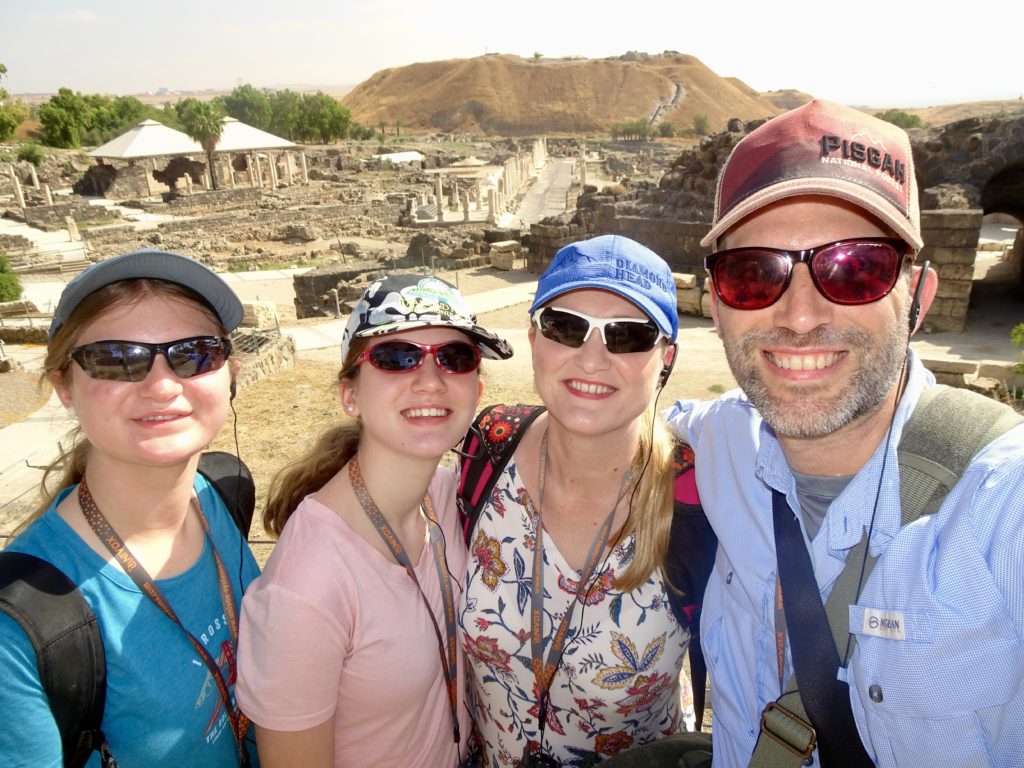
Bet-She’an is located about five miles northeast of Mt. Gilboa along the Harod Brook, where the Jezreel Valley meets the Jordan Valley. The site today contains a large Tel comprised of approximately 20 strata dating back to 5th century BC. This Tel has mostly not been excavated. It is likely that within one of these strata is the wall where Saul’s body was hung.
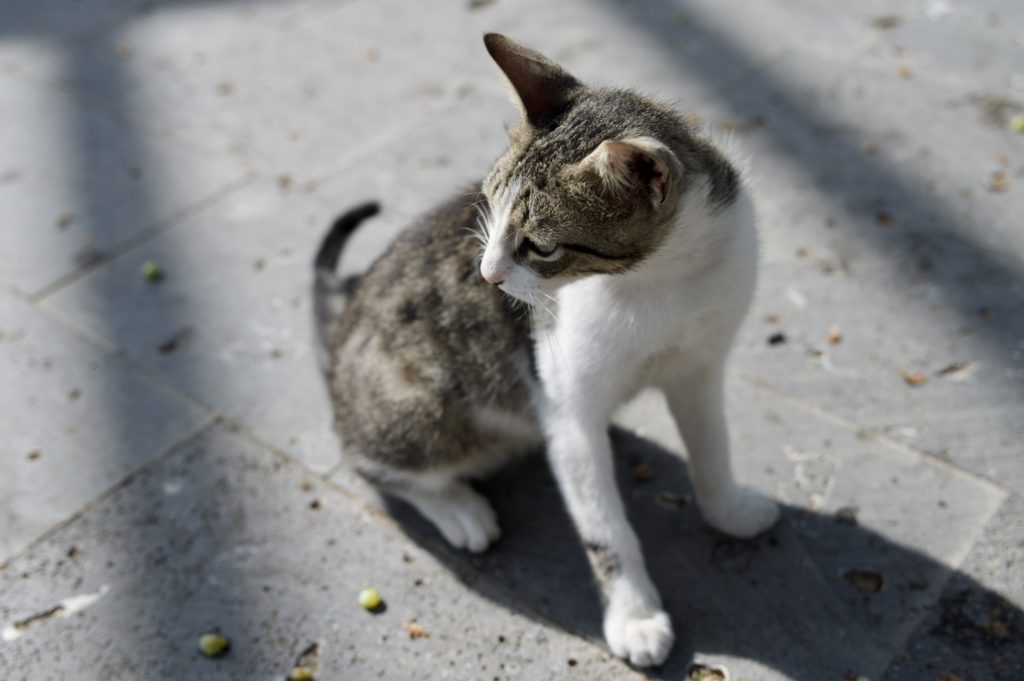
During the Hellenistic period, the city spread out around the tel, eventually encompassing over 400 acres. During the Hellenistic Period, the city was included in the Decapolis under the name of Scythopolis (“city of the Scythians”).
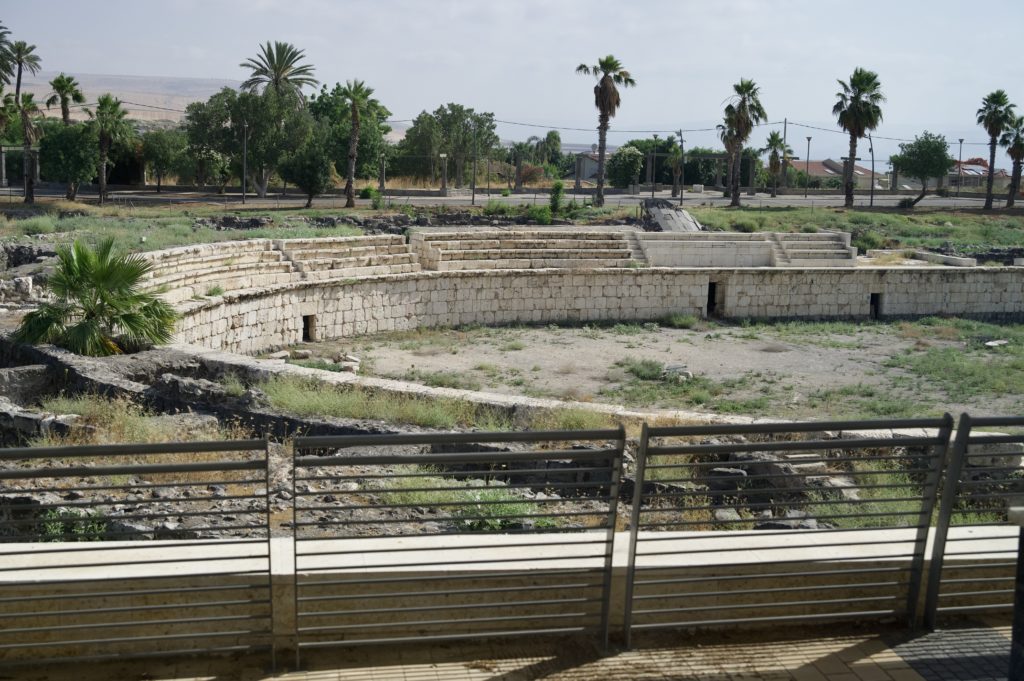
Before we even arrived to the entrance of Bet-She’an, we were able to see an excavated amphitheater from the bus. I did not see this last time I was here. An amphitheater was a complete oval arena and was used for sport (Usually gladiator fights to the death).
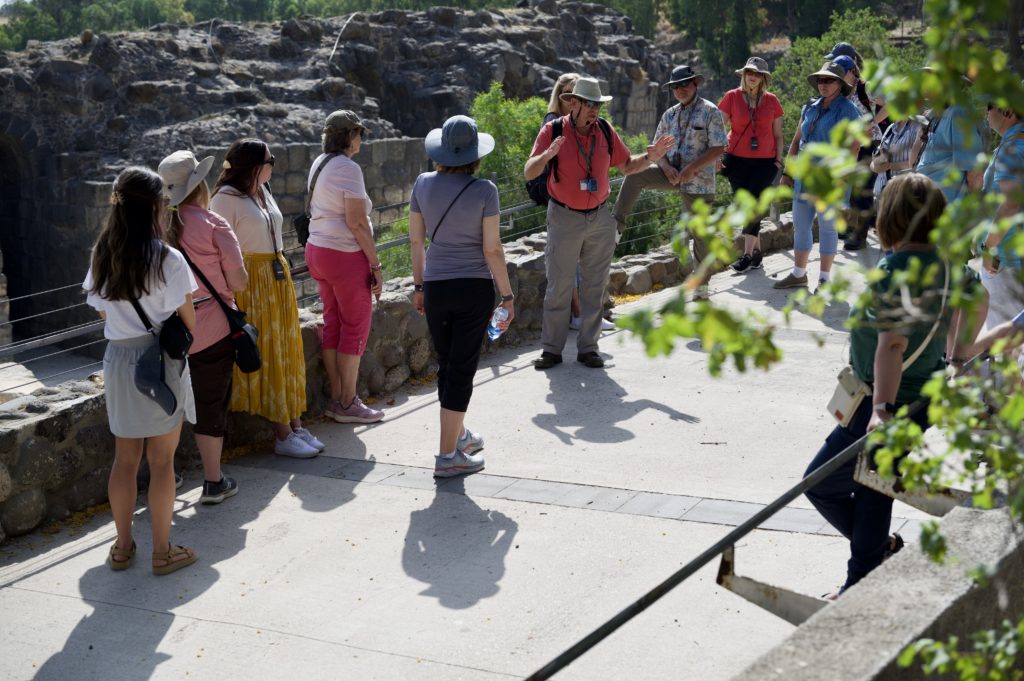
Once we arrived at the main site, Ami talked to us about the city, the history of the relationship between Israel and the Philistines, and about the death of Saul from 1 Samuel 31 and David’s lament from 2 Samuel 1.
He said that at its peak Bet-She’an had a population of over 45,000. The structures within the city were made of basalt, limestone, and marble. The marble was imported from other parts of the Roman Empire because it is not found in Israel.
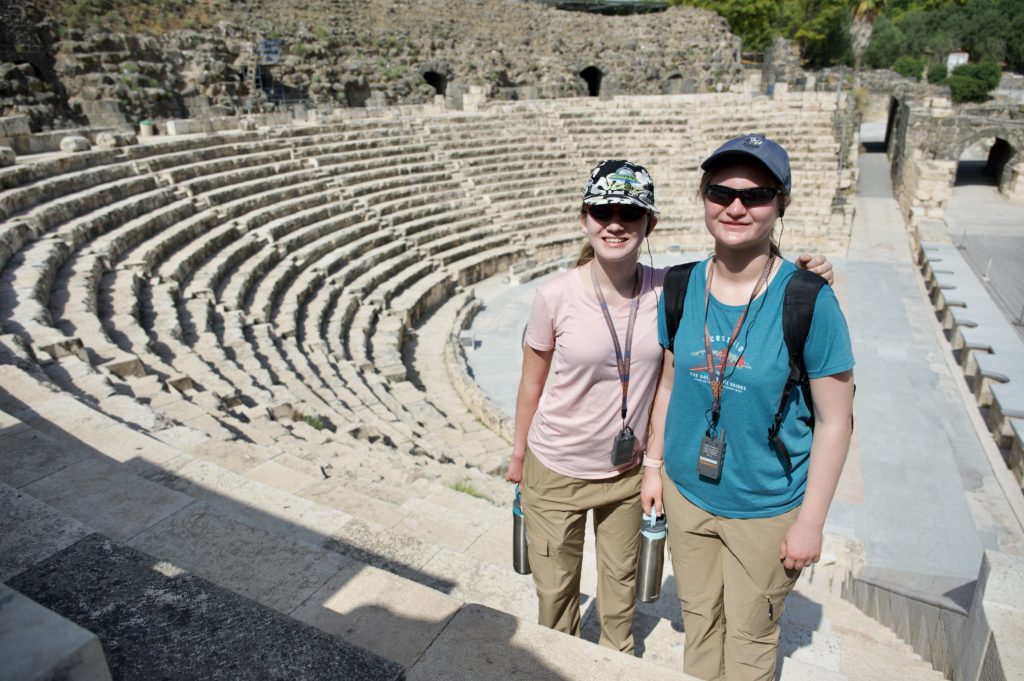
Ami then led us through the site starting with a very large Greek-style theater that is incredibly intact. He explained to us about its construction and the use of the Roman arch for the entrances to the theater.
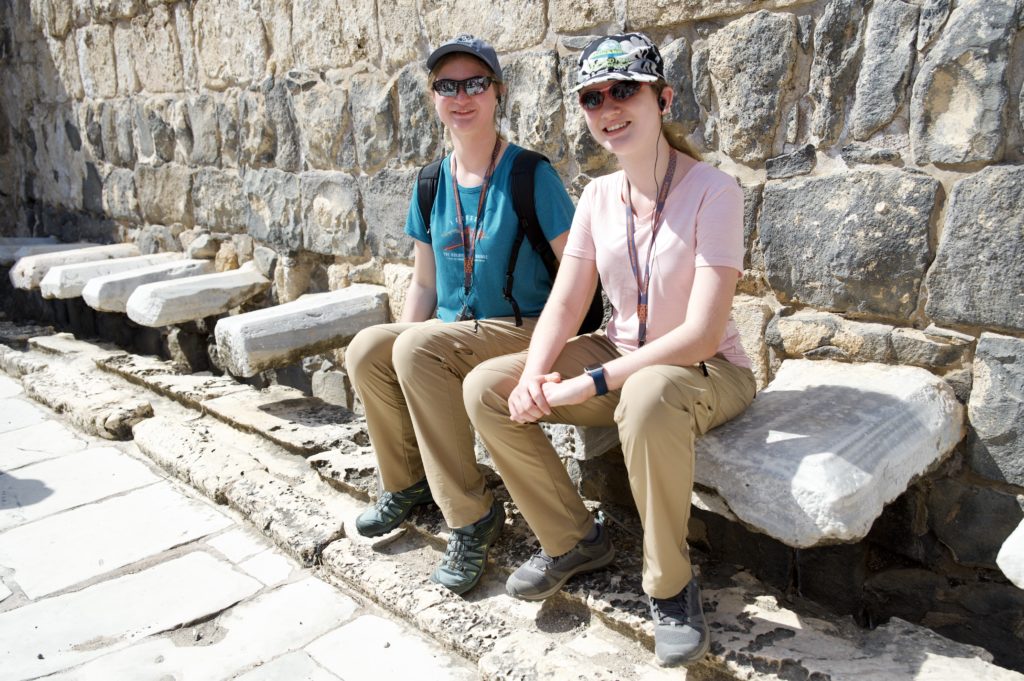
Next, we moved to a public toilet that is just down from the theater, and many in the group took turns “trying them out,” including Kate, Sara, & Olivia.
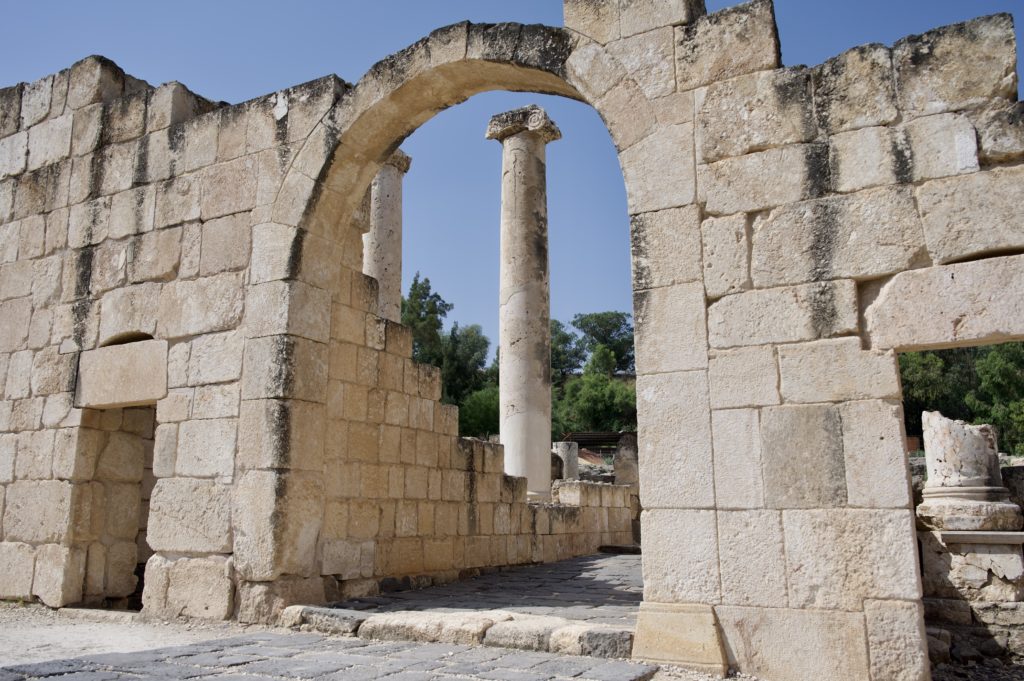
We then saw shop fronts along a city street.
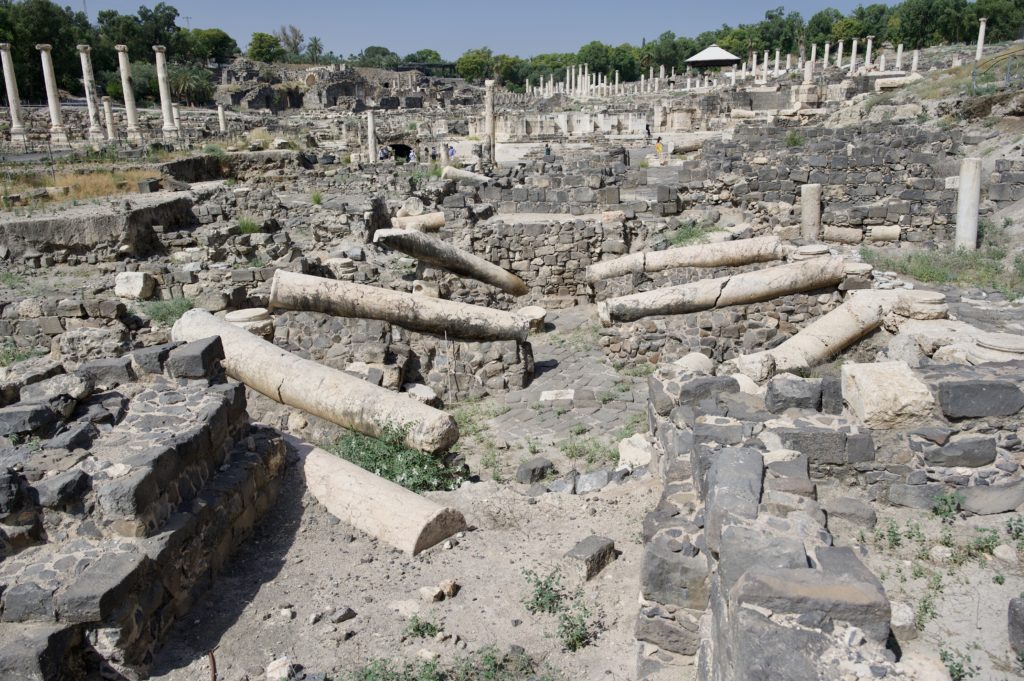
All along the way, Ami pointed out fallen columns that have been excavated that were destroyed in earthquake. The columns were left in place and new structures built on top of them.
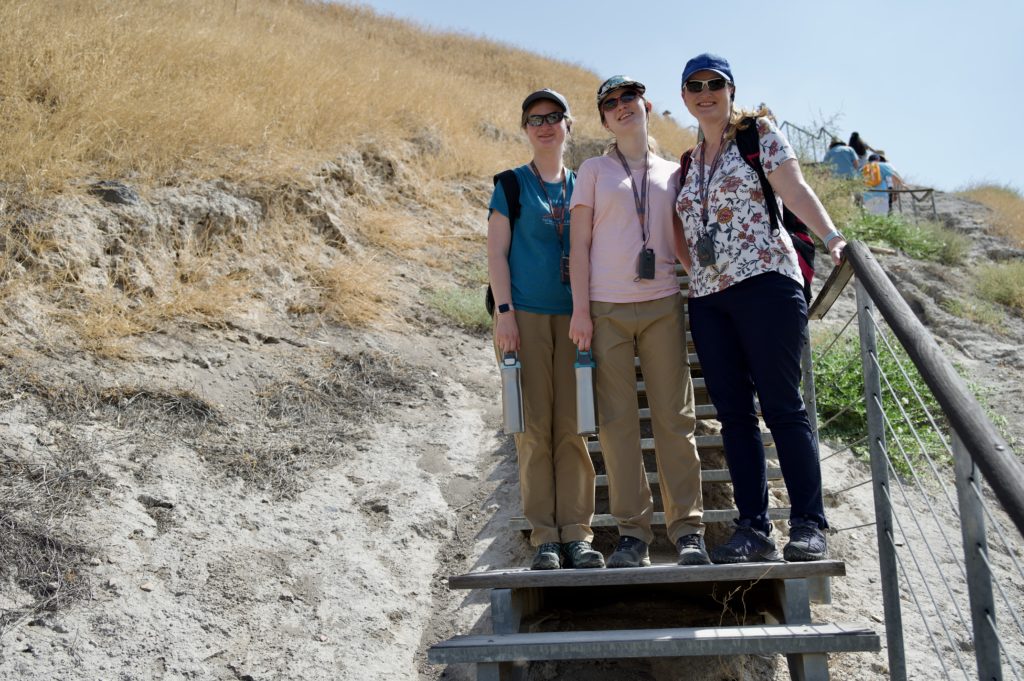
Ami led a few of us up to the top of the Tel…
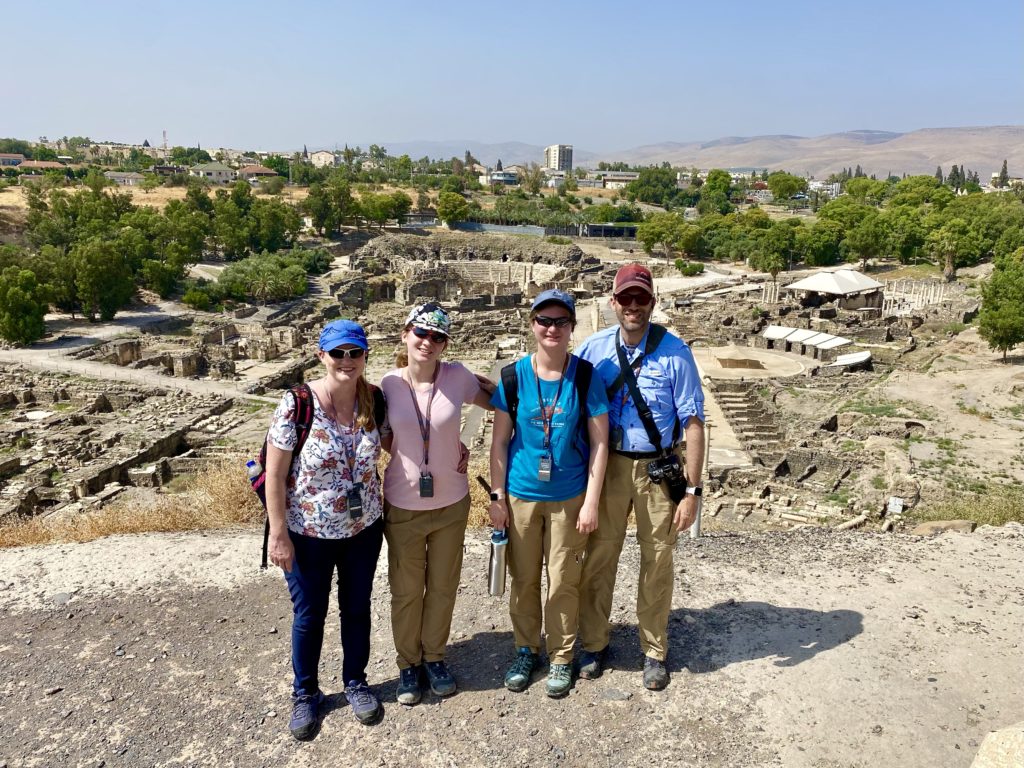
…which provided an incredible view of the entire site.
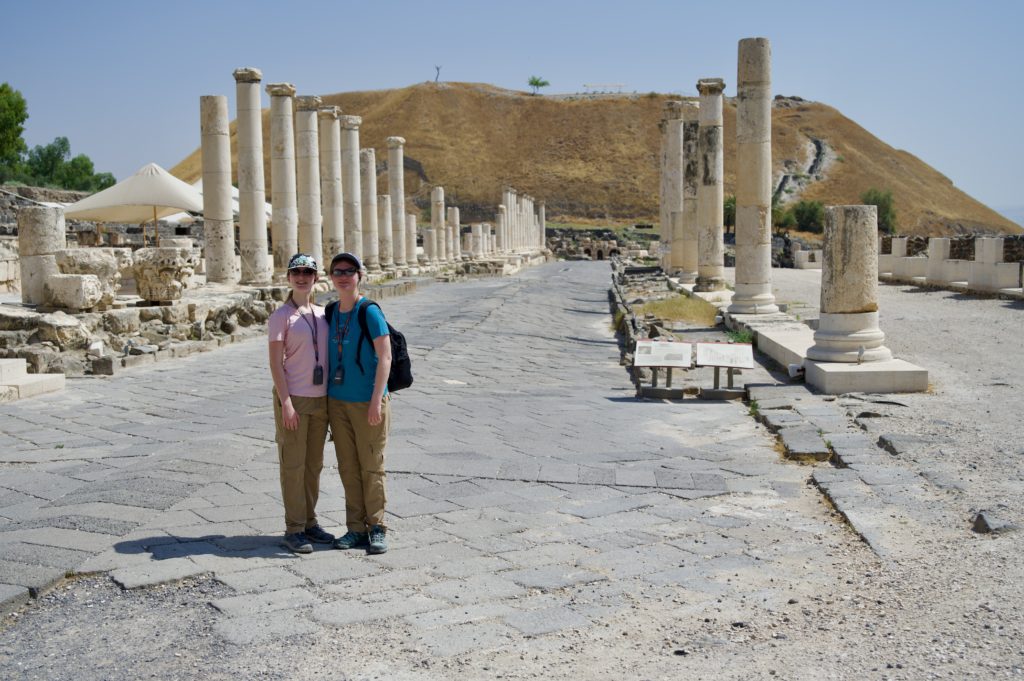
After coming down, we visited Palladius Street that was lined with columns and had an underground drainage “pipe” running under the street. This street is incredibly impressive.
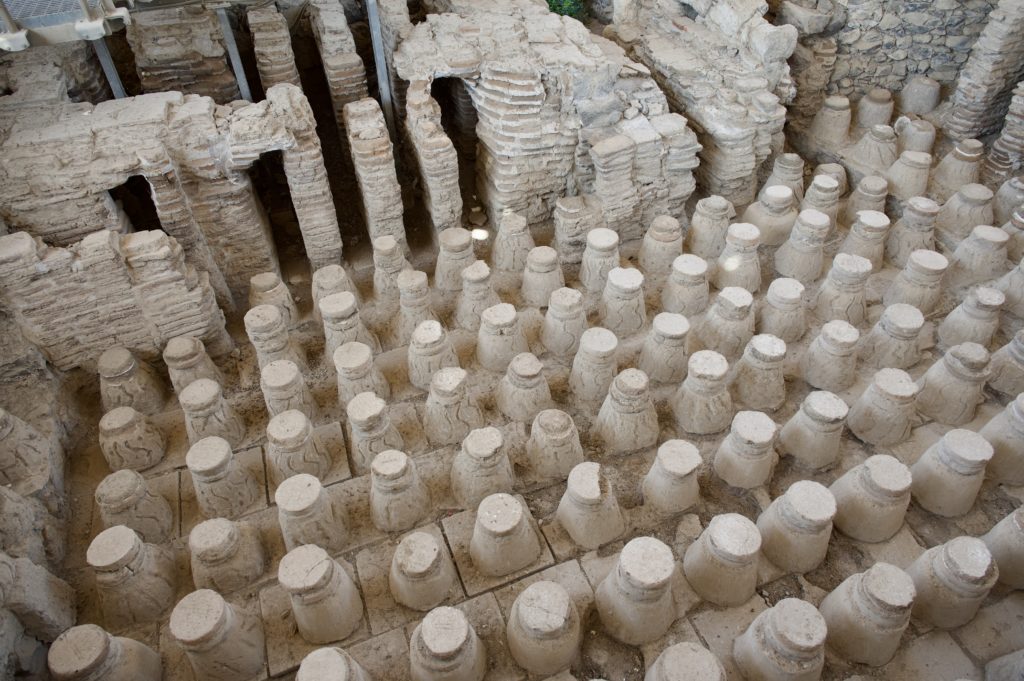
Our final stop was a bath house that includes 3 rooms (1) hot room or sauna (2) cold room (3) cool room for transition from sauna to cold. Note the remains of pillars made of mud bricks that were used to lift up the floor. Slaves would burn wood outside through arches to heat the sauna. This was a very large structure, and Ami equated it to a modern-day country club.
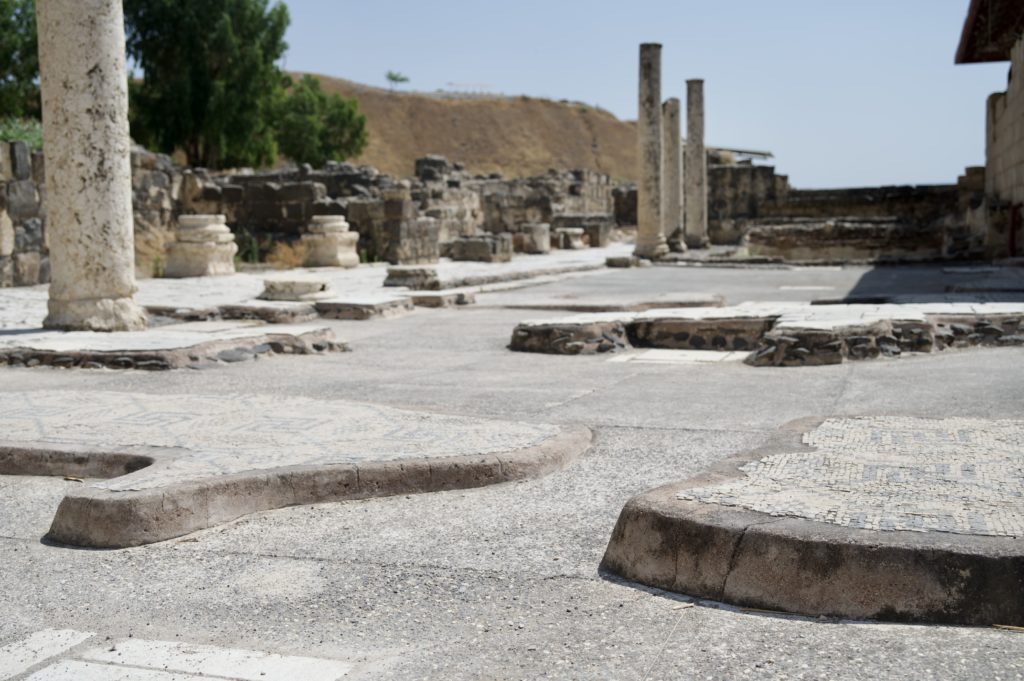
Around the bath house there are roads where you can see several layers or strata over the centuries. One of these layers contained intricate mosaics.
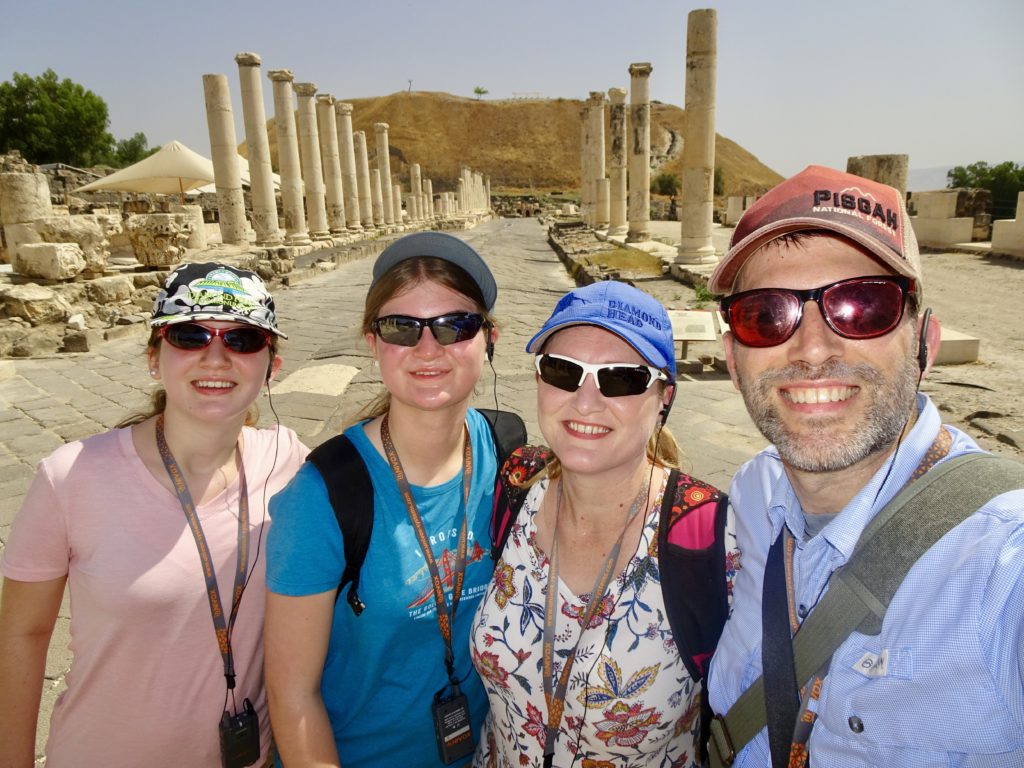
As we left Bet-She’an, I read from 1 Samuel 31 about the death of Saul and his body and armor being taken to Bet-She’an. Ami then read the lamentation of David from 2 Samuel 1. Right as we were reading the passages, we drove by Mt. Gilboa which is the place where Saul and Jonathan died.
We continued south along the Jordan valley on left and soon came to the Samaritan mountains to right.
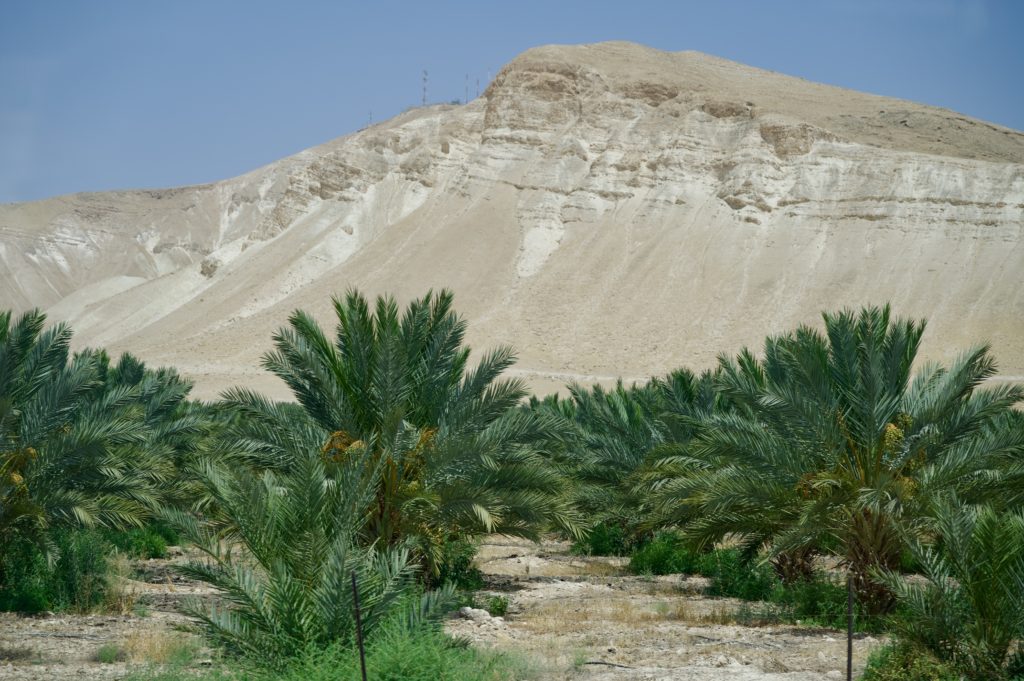
Later we transitioned from the Samaritan mountains to the Judean mountains as the terrain became more and more desert like.
Qumran
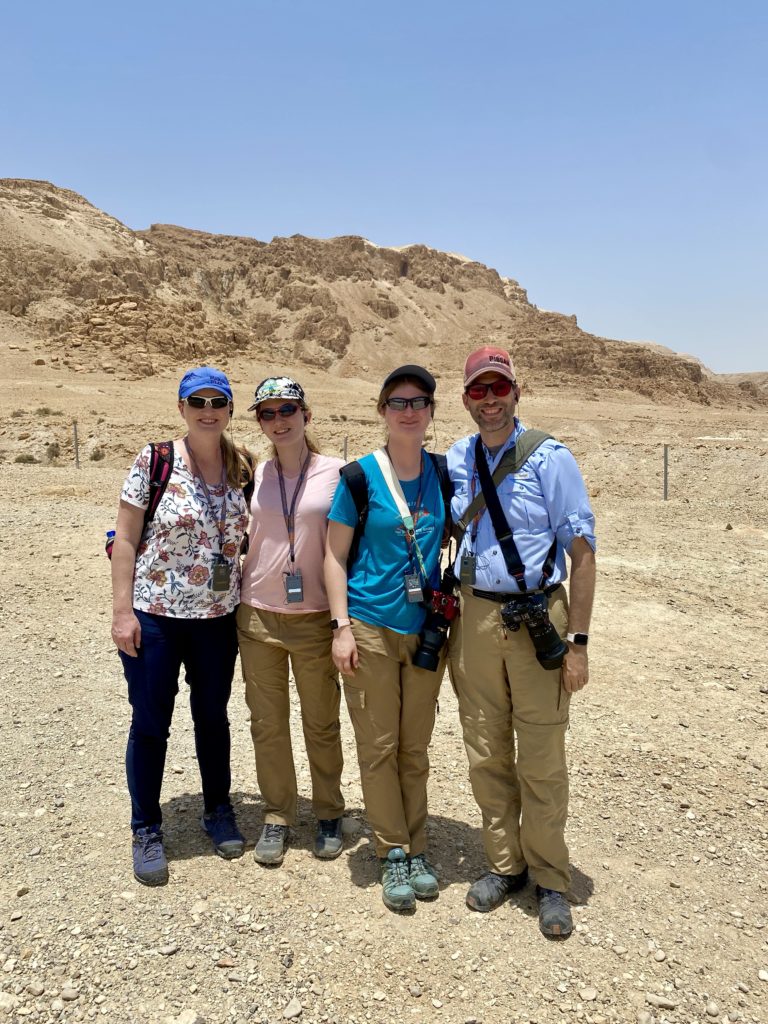
Our next stop was at Qumran which we entered after just having seen the Dead Sea for the first time. When we got off the bus, it was still very hot, but the air was much drier, which was nice. The last time I came to Qumran it was in January and it had just stopped raining when we arrived. Didn’t feel like it was going to rain there anytime soon today.
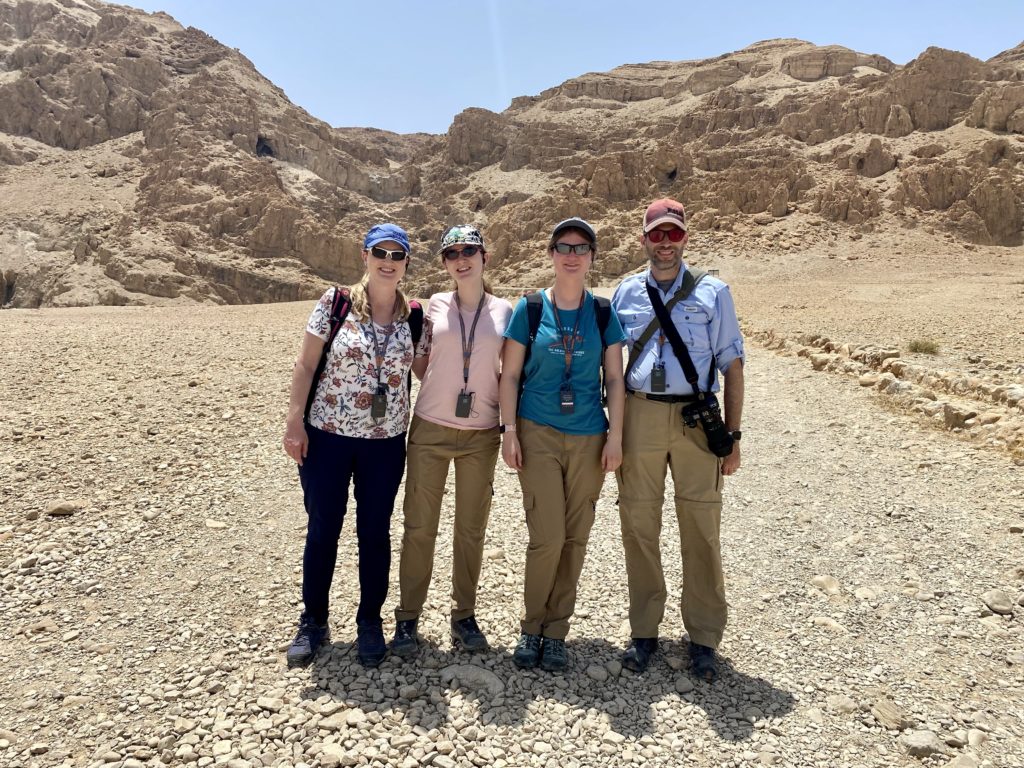
Qumran is the site where many of the Dead Sea Scrolls were found beginning in 1947. It was also the home of the Essenes during the time of Jesus, who were one of the three Jewish sects identified by Josephus. At the site, Ami told us about the Essenes. They were a group of scholars who left Jerusalem to setup a new community for themselves in Qumran with no contact to the larger Jewish world.
They committed themselves to preserve the word of God on scrolls. The scribes made meticulous copies with no mistakes. If any mistakes were made, the scroll would be buried because you cannot destroy the word of God.
When the confrontation became intense between the Jews and Romans in 66 AD at the time of the first Jewish revolt, the Essenes placed their scrolls in jars and hid them in caves to protect them. When the Romans eventually destroyed the village, they didn’t find the scrolls. They weren’t found until almost 2000 years later.
Qumran is a very important archaeological site, because the Dead Sea Scrolls contain fragments from the time of Jesus and they include representations from all books of the Old Testament, except for Esther and Nehemiah, including the entire book of Isaiah. This discovery proves that the Old Testament we have today is essentially the same as what Jesus had during his time. The wordings / translations are very similar to what we have today.
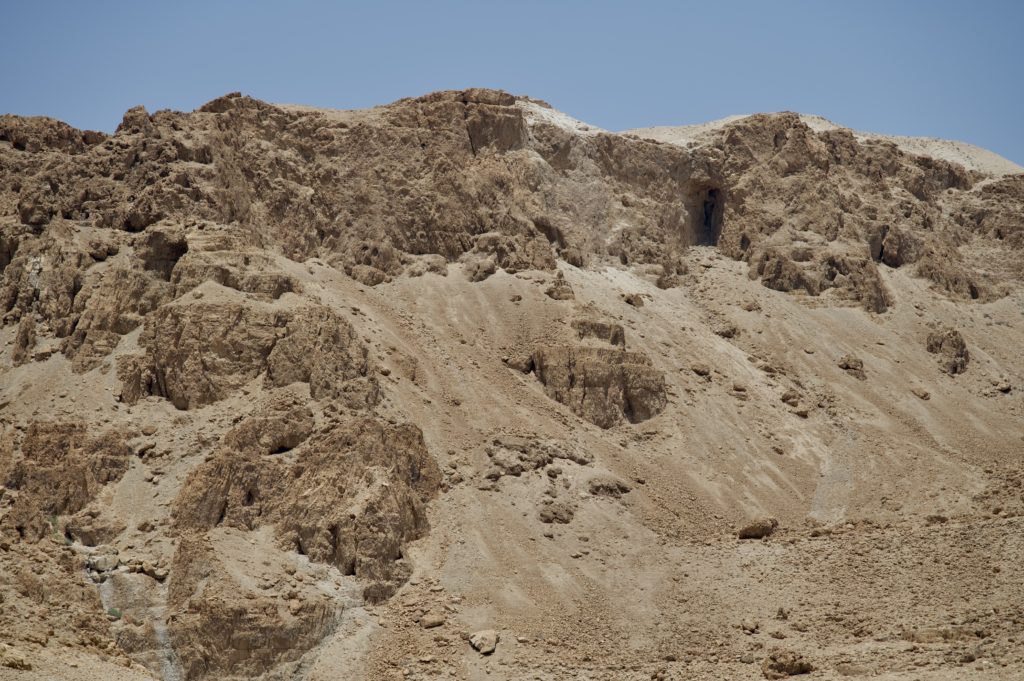
Ami took us on a tour of the site, and we walked through the excavations of the ancient village of Qumran. We saw “Cave 1” at the top of the mountain at the northern end of the site where three Bedouin farmers found the first 8 clay jars in 1947 (Including the book of Isaiah). These farmers had no idea what they had found and sold them to a dealer in Jericho for $16.
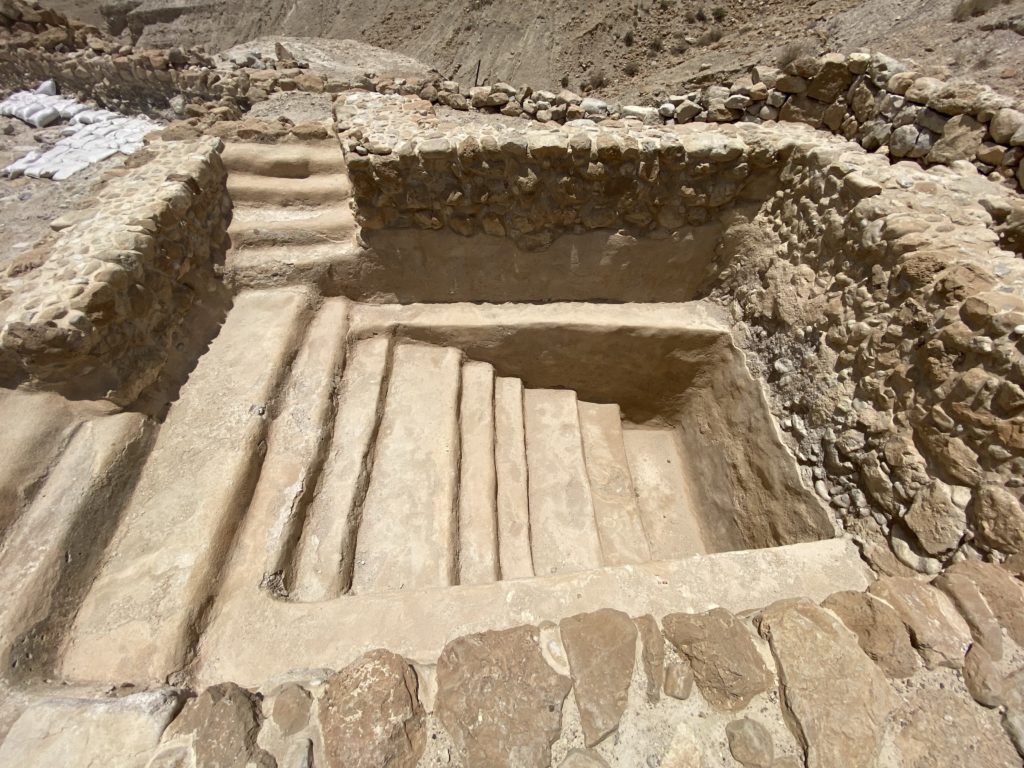
We saw numerous mikvah or ritual baths in the village. Ami said that a scribe would have to fully wash before writing, so there would have been a need for many baths.
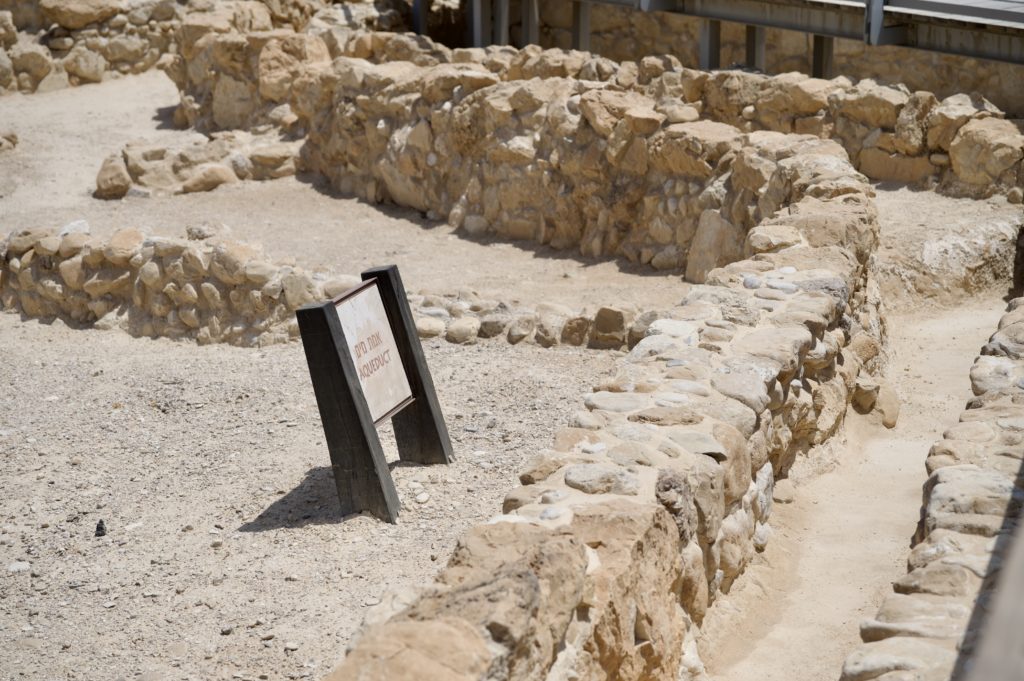
We saw an aqueduct used to transport water throughout the city as well as a couple of cisterns used to hold water.
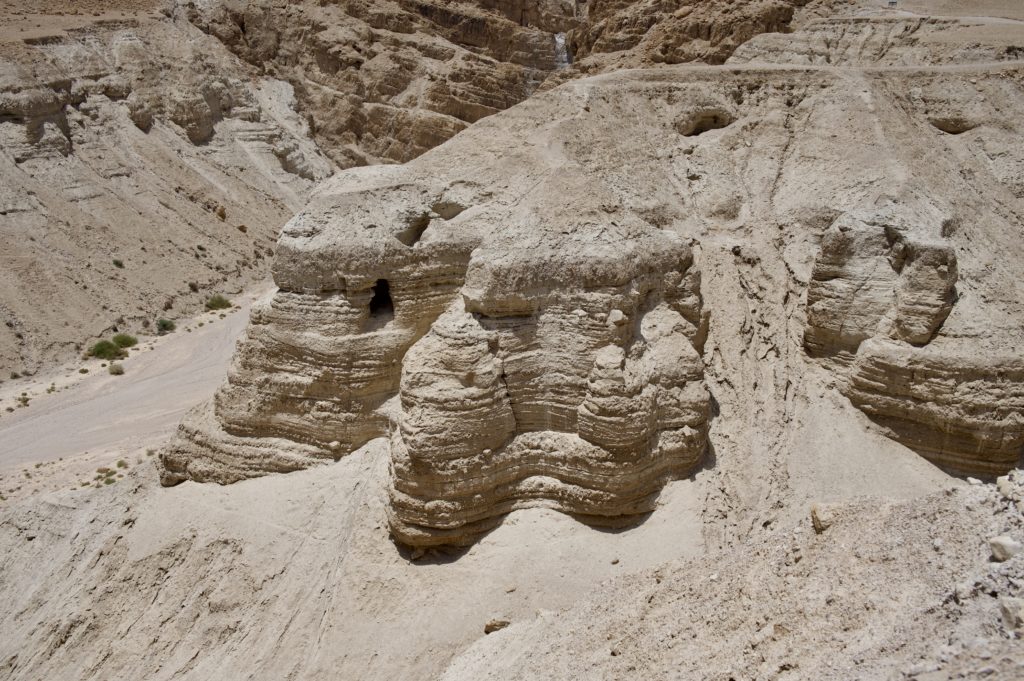
At the southern end of the site, we saw “Cave 4” down in a valley of the Qumran Wadi. Bedouin farmers discovered this cave in 1952 and ultimately 15,000 scroll fragments were found that made up 530 total scrolls. This is my favorite part of the site.
After completing our tour, the whole group went inside the visitor center for lunch.
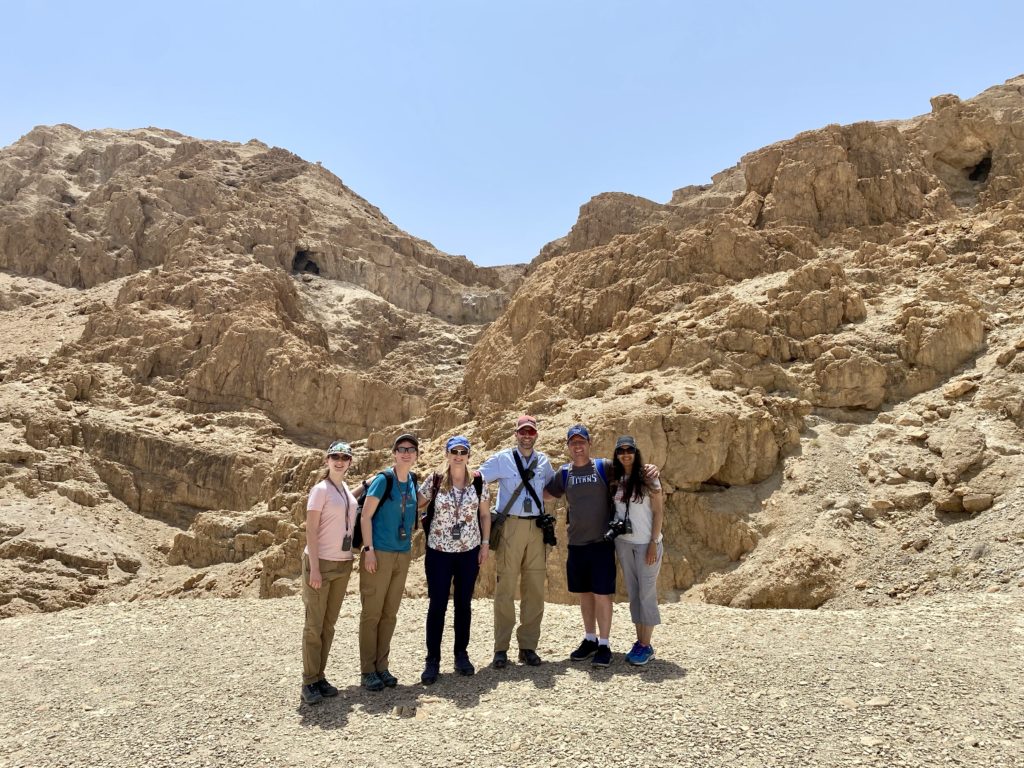
After lunch, while most of the group was shopping, our family went back out to the site with Daniel and Jana Palk and hiked part of the way up to one of the caves (after some research, I believe it is cave 6, but am not 100% confident this is correct).
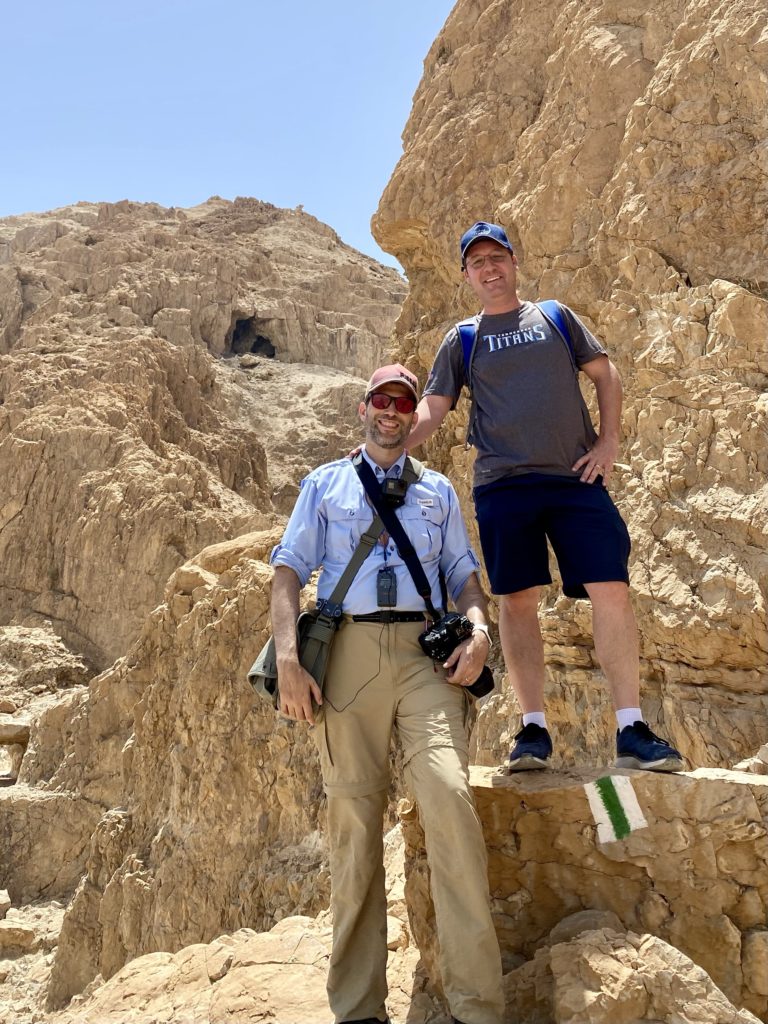
On the way we met a young man from Korea named Minoah, who joined us for part of the hike. This was a lot of fun and provided some great views of the site and the Dead Sea.
En-Gedi
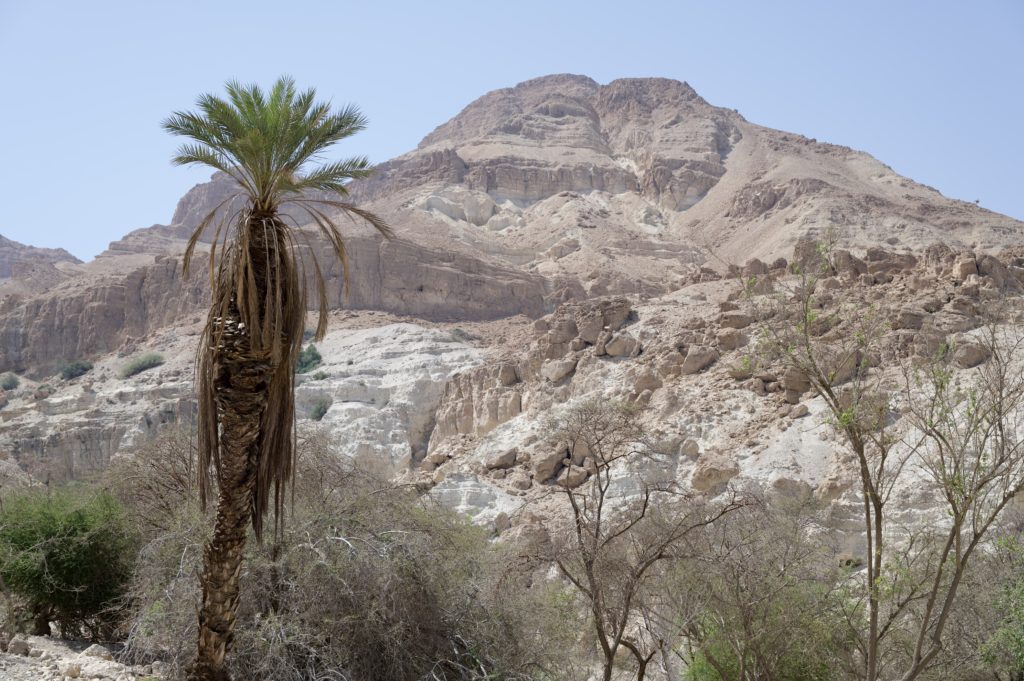
Back on the bus, we continued to head south along the Dead Sea toward the En-Gedi Nature Preserve. The name En-Gedi means “spring of the goat” or “spring of the kid.” It gets this name from the freshwater spring located there and from the many wild goats (Ibex) which live in the area. When I was here in January 2020, there were Ibex everywhere, but we only saw a very few today from a long distance away. Ami said that they do not like to come out of the caves in the heat.
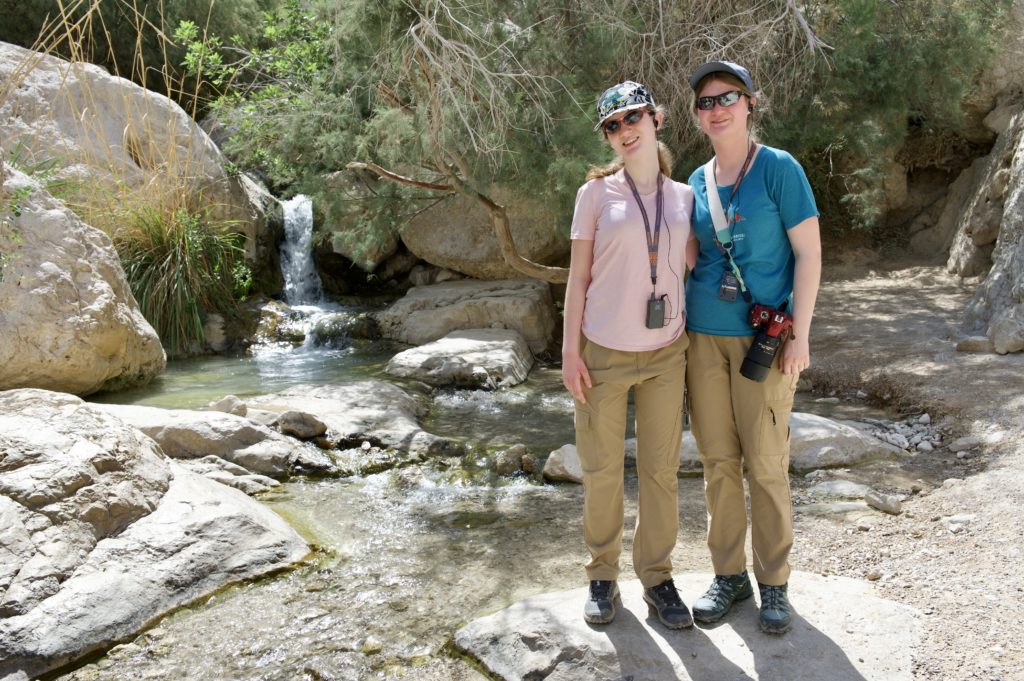
En-Gedi is mentioned numerous times in the Old Testament:
*Joshua 15:62 first mentions En-Gedi in the tribal allotment given to Judah.
*When fleeing from Saul, David left his place of refuge in the wilderness and dwelt in the strongholds of En Gedi (1 Sam 23:29).
*In one of the caves there, David cut off the corner of Saul’s robe when he had entered to “relieve himself” (1 Samuel 24).
*In 2 Samuel 22, David sings a song of praise to God for delivering him from Saul and in verse 2 calls God his rock, stronghold, and deliverer.
*The Song of Solomon (Song 1:14) describes En-Gedi as a vineyard (“fruitful of oasis”) when talking about his beloved.
*2 Chronicles 20:1–2 says that in the reign of Jehoshaphat (800 BC) during the Divided Monarchy, an army of Moabites and Ammonites camped at En-Gedi in preparation to invade Israel.
Ezekiel prophesies about a time when fresh waters will flow from the Temple in Jerusalem down to the Dead Sea and make the Dead Sea fresh: “From Engedi to Eneglaim it will be a place for the spreading of nets” (Ezekiel 47:10).
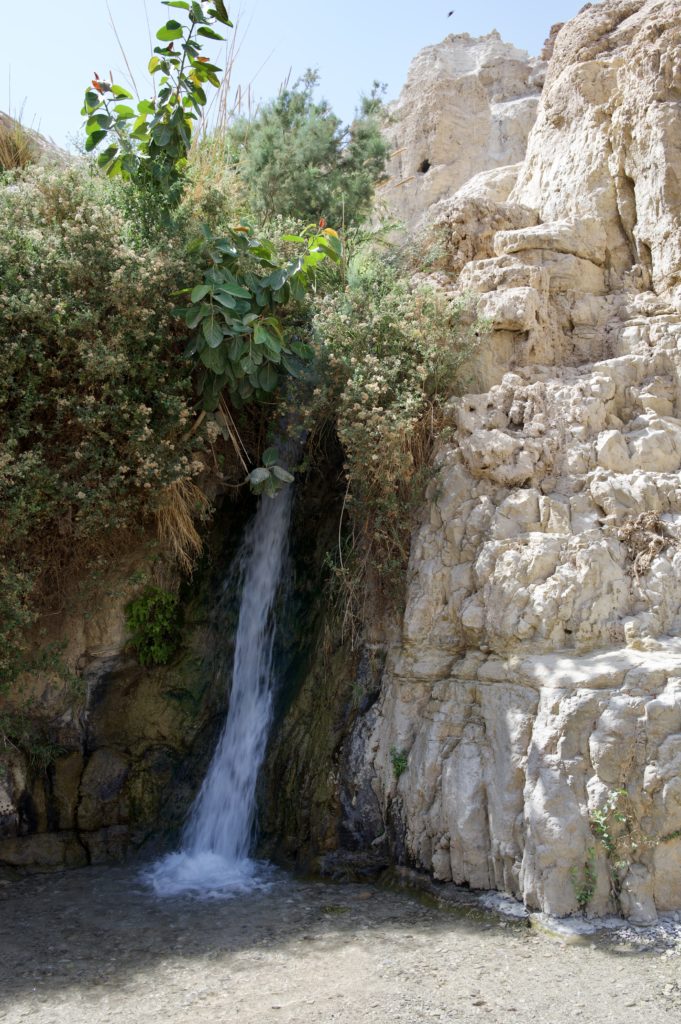
At En-Gedi, Ami took us to one of the lower waterfalls, and told us about the history of David and Saul at this place.
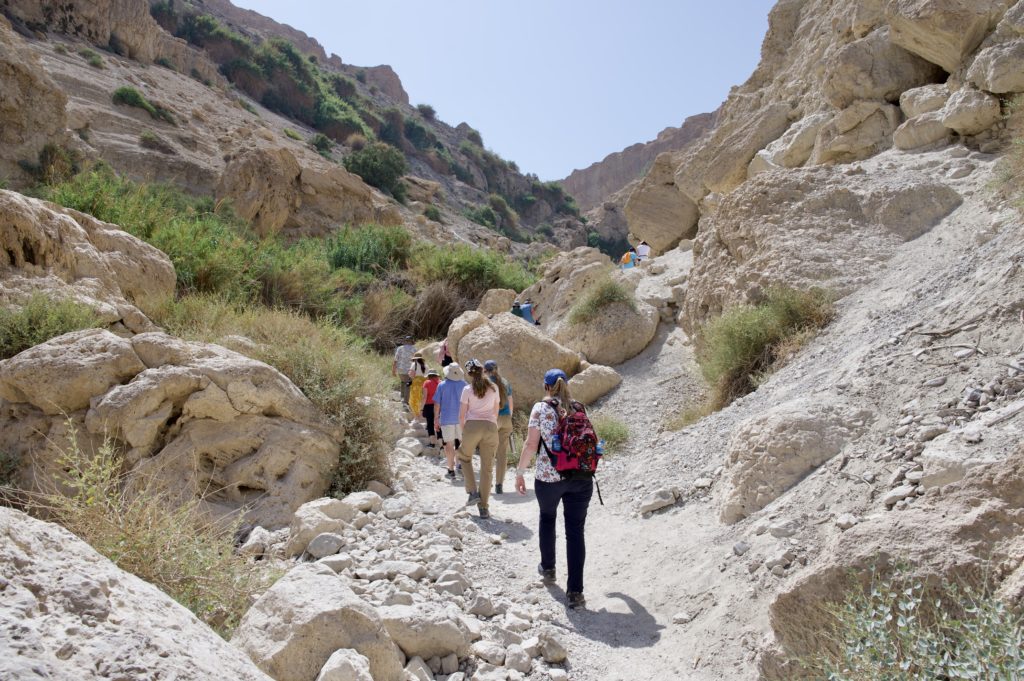
After he finished, about half of our group made the hike to the top of En-Gedi, seeing numerous waterfalls and incredible views, culminating with the beautiful David Waterfall.
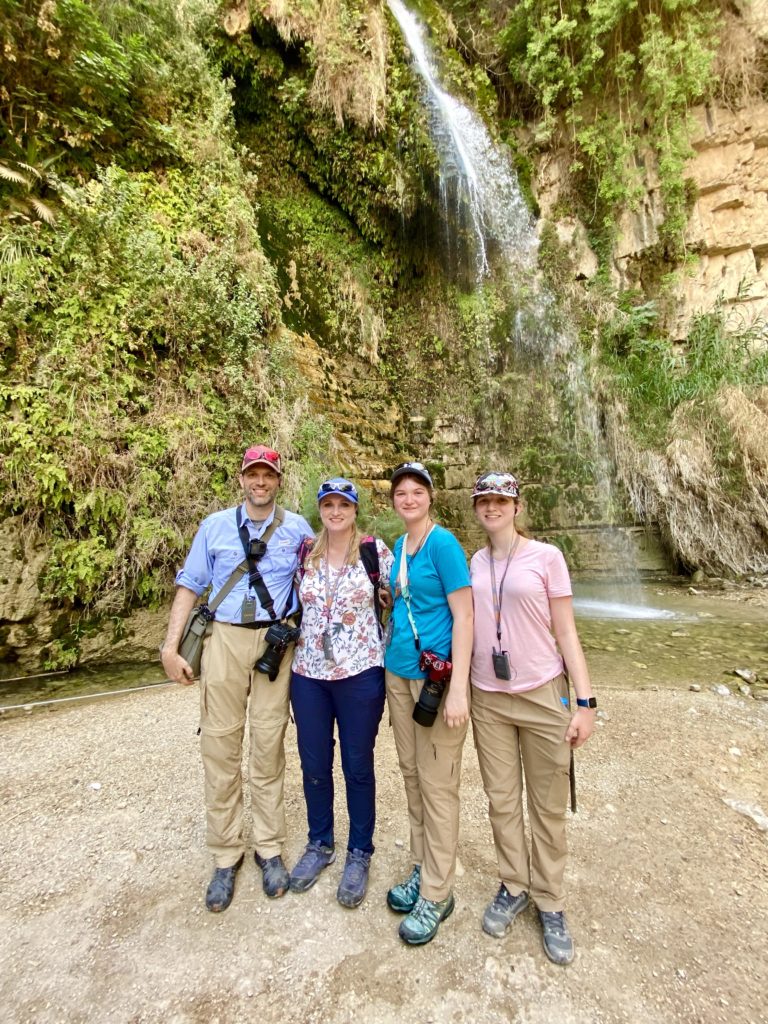
This place is breathtaking, and we hiked a lot further today than we did when I was here in 2020.
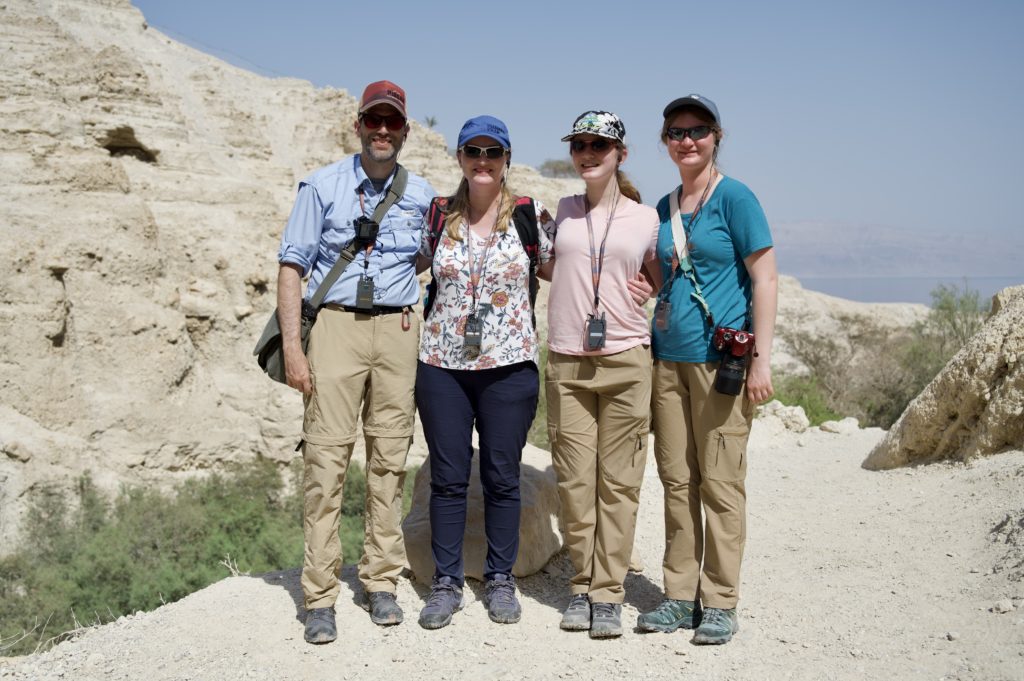
Back on the bus we continued heading south to our hotel in the resort area of Ein Bokek, where we will be staying for one night.
The Dead Sea
Once we arrived at the hotel, we quickly took our luggage up to our rooms and changed into our bathing suits for a float on the Dead Sea.
The Dead Sea is the lowest place in the world at 1,412 ft (430m) below sea level. The water in the Dead Sea is 36% salt, 8 times more than any ocean. Needless to say, nothing can grow in this lake. It is 50 km long, 18 km wide, and 300 m deep at its lowest point.
The Dead Sea used to be much larger, but since the flow of the Jordan River is now being controlled by a dam, the water in the Dead Sea is receding 1.5 meters every year. Today the northern and southern parts of the Dead Sea are completely disconnected, and they must channel water from the northern part to the southern resort area where our hotel was located.
Along the way down on the bus, we could see numerous sinkholes that have been caused by rapidly receding waters.
There are 16 references to the Dead Sea in scripture. It is referred to by the names “Salt Sea” (Gen 14:3; Num 34:3, 12; Deut 3:17; Josh. 3:16, 12:3, 15:2, 5, 18:19), “Sea of the Arabah” (Deut 3:17, 4:49; Josh 3:16, 12:3; 2 Kgs 14:25) and the “Eastern Sea” (Ezek 47:18; Zech 14:8).
The names are used once each to communicate direction (toward the). Only once is the Dead Sea designated as a location (Gen 14:3). The remaining 12 references to the Dead Sea are used in the context of describing the borders of the promised land.
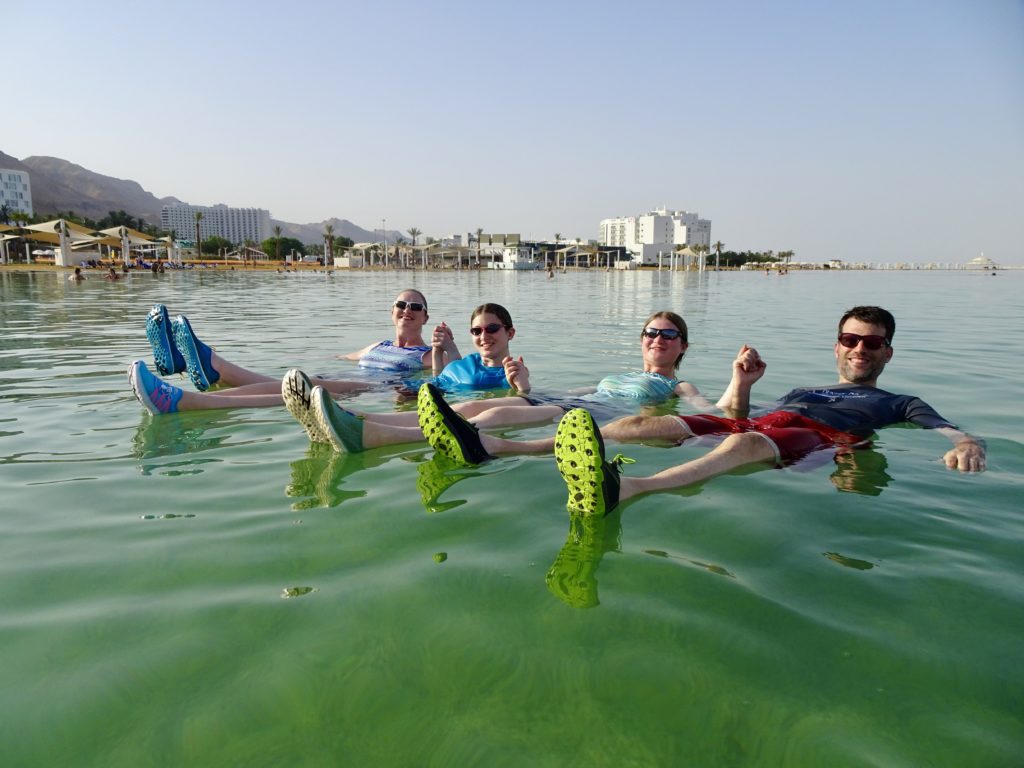
At the beach in Ein Bokek, I watched Olivia, Kate and Sara get in the Dead Sea and float for the first time. I loved seeing their reactions when they laid back in the water. After recording a little video and taking some pictures, I joined them in the Dead Sea. Floating here is surreal, and unlike anything I’ve experienced anywhere else. There is absolutely no way to NOT float.
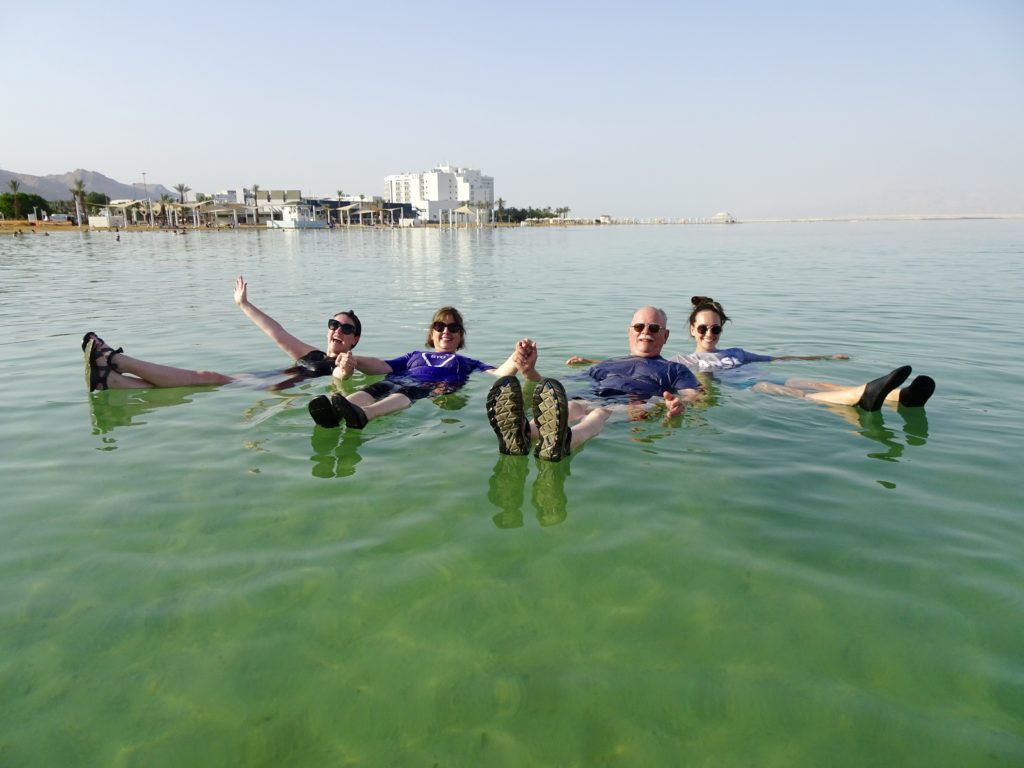
Another thing I loved seeing today was my co-leader, Bruce Zupa, floating in the Dead Sea with his daughter Lisa and Granddaughters Becca and Stacey Layne. Bruce has been to Israel six times before, but today was the first time he’s ever floated. I’m glad I got to see it.
It was a lot of fun hanging out with our group in the Dead Sea and seeing most of them experience it for the first time. We ended up spending over an hour there floating, talking, and playing (not splashing). Both Kate and Sara said that this was their favorite thing today, and I’m not surprised.
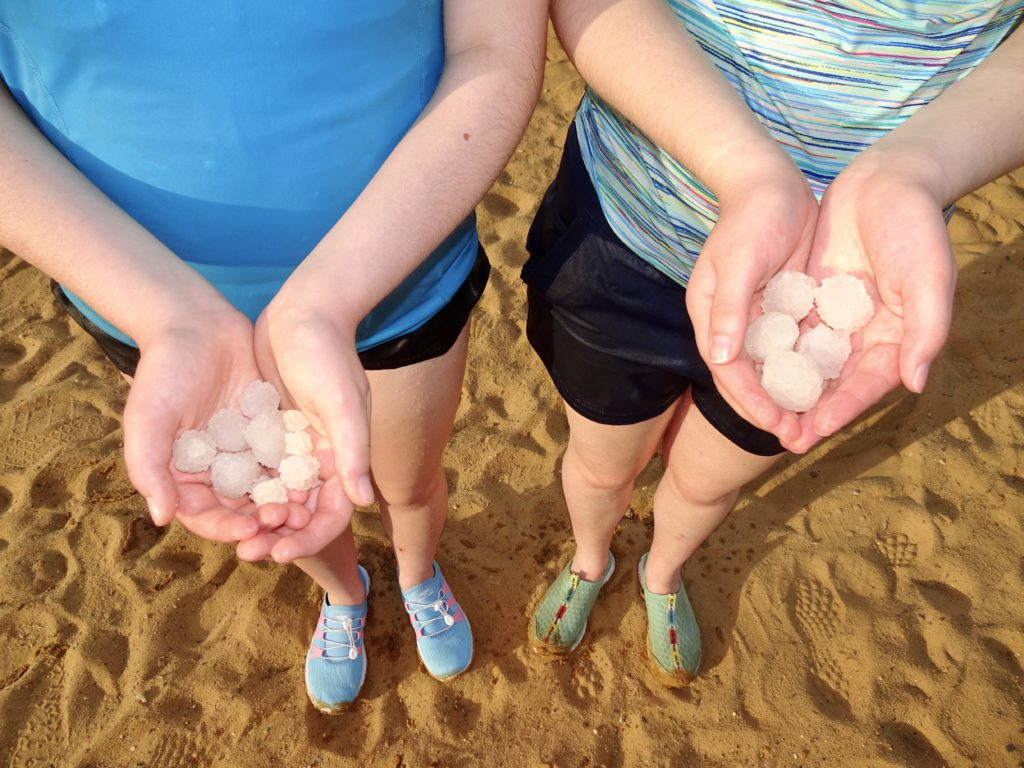
One note about the difference between today and my last trip. Back in January 2020, the entire bottom of the sea, all the way from the shore, was coated in large balls of salt, just slightly smaller than golf balls. Today you had to walk out a long way to find even small balls of salt, and much farther to find the larger ones. I’m very curious as to why this is different. Is it the temperature? Is it that the water levels are higher? I’m not sure but do find it fascinating.
After getting cleaned up, we had a delicious dinner in the very busy main dining room before calling it a day. All-in-all this was another fantastic day in Israel.
